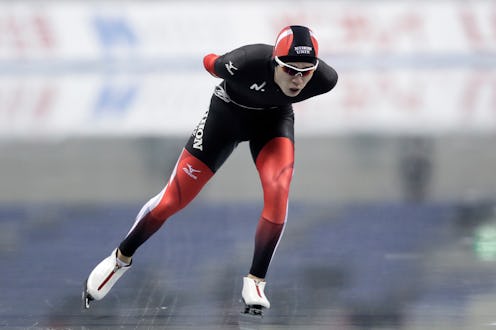News
Everything You Need To Know About The Different Kinds Of Ice Skating In The Olympics

Scheduled to begin on Feb. 9 in PyeongChang, South Korea, the Olympic Winter Games will host a variety of different sports challenges, including the daunting and physically-demanding art of skating. In the 2018 Winter Olympics, there are three types of skating. And they're all pretty intense.
Here are the three types of skating in the 2018 Winter Olympics:
- Figure skating.
- Short-track speed skating.
- Long-track speed skating.
Let's get into figure skating first. The sport, which requires performers to complete exhilarating and sometimes downright physical challenges on ice, has a rich history. While it's easy to image figure skating as just a sport where athletes twist and twirl on ice while draped in glimmery and tight clothes, figure skating is actually the oldest winter game in the Olympic games. Originally, figure skating was inspired by both ballet and waltz, and sometimes athletes can spin at over 300 revolutions per minute (RPM). Further into figure skating, there are sub-events. There's the men's singles, women's singles, and then pairs-mixed events.
There's also short-track speed skating. In short-track speed skating, the athlete's challenge is his or her opponent. The idea isn't to complete the track in the shortest time but rather, defeating the rival pair or team. This means the athlete has to brainstorm their own trajectory, how they'll outspeed their rival, how to maneuver their own body while on track, and how to keep ahead of others. It's a pretty breathtaking spectacle.
In short-track speed skating, multiple players get ready to race against each other in skates while on ice. Normally, there are four to six players competing on an oval-shaped rink that is typically 200 feet in length and almost 100 feet in width. The rules are simple. You can't push, block, or thrash an opponent, and you also can't help your team member with gaining speed. So, no lending arms to go forward.
Then there's long-track speed skating. It's also simply known as speed skating. You've probably inferred what the whole sport is about by looking at the name. In speed skating, athletes have to finish the designated distance in the shortest time possible. People from Netherlands, South Korea, Germany, Canada, Russia, and Sweden - among other places - participate in this grueling sport that leaves people breathless - literally.
While these winter games sound pleasantly rigorous, they're also demonstrably dangerous and should be performed by trained athletes or under supervision. According to the United States National Library of Medicine, the most frequent injuries that take place because of short-track speed skating are knee-lacerations and ankle fractures. It won't hurt - so to speak - to be careful.
Apart from these figure skating, long-track speed skating, and short-track speed skating games, the 2018 Winter Olympics will also host other winter sports, such as curling and bobsleigh (which looks crazy fun). There's also biathlon which combines both cross-country skiing and shooting a rifle.
Of course, there's also ice hockey and freestyle skiing for the adventurous types who enjoy a bit of their own personal style while they're skiing across challenging and icy landscapes. There's also skeleton which sounds like a Halloween-y thing but "skeleton" is basically a sport where one athlete uses their body weight on a small-sized sled while facing down.
In addition to these winter games, the 2018 Winter Olympics will also feature Nordic combined skiing, luge sledding, ski jumping, and snowboarding. In other words, Olympic fans can expect to see a lot of skating, skiing, sledding, and naturally, freezing as temperatures in PyeongChang are expected to drop.